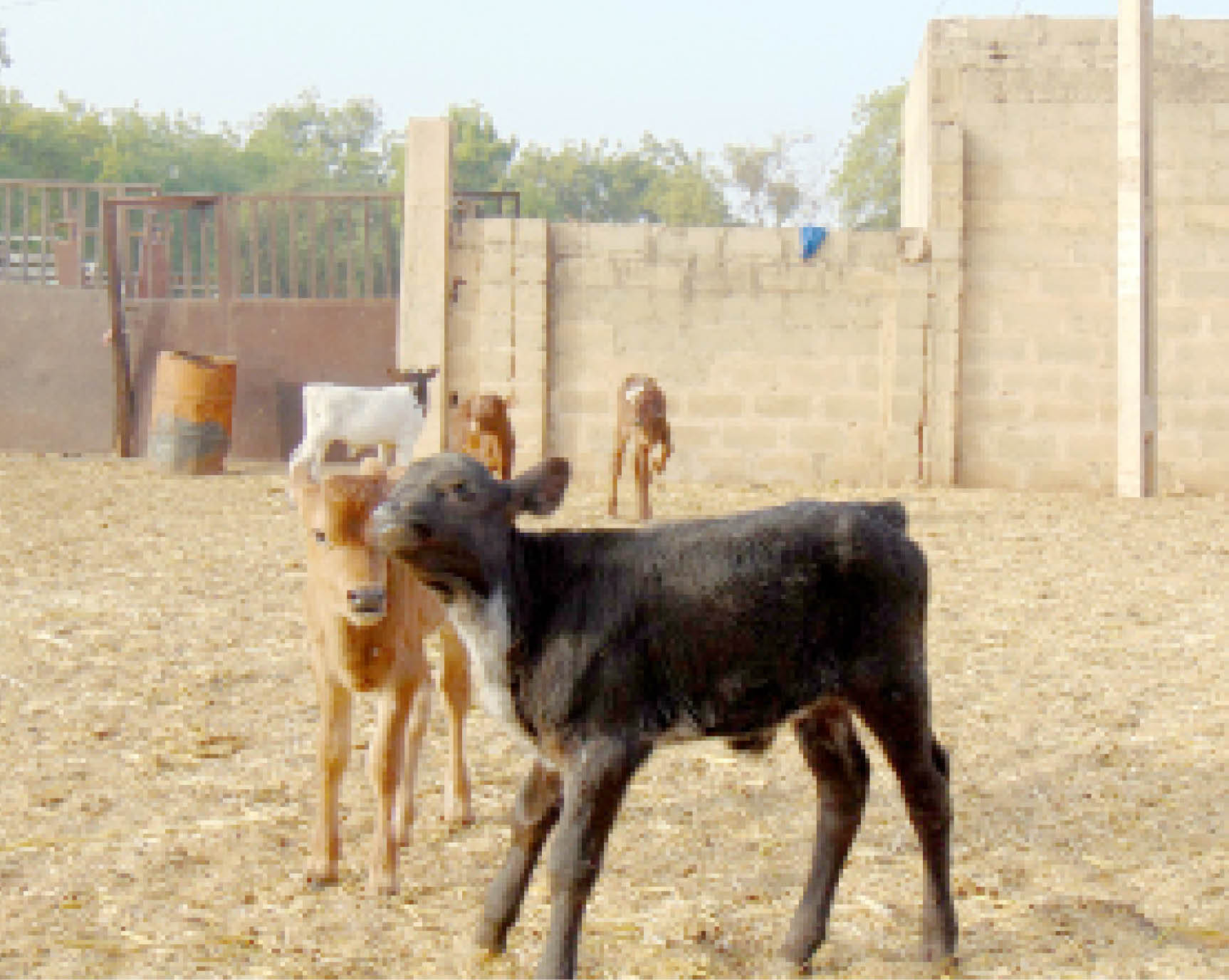By Tadaferua Ujorha who was in Sokoto
The importation of exotic cattle and crossbreeding these with local species will produce more milk and meat, while settling the pastoral Fulani in reserves. Sokoto’s 3.4 million cattle, 19 grazing reserves, 144 vets and artificial insemination and embryo transfer laboratory lie at the heart of great changes occurring in the livestock sector estimated to earn N500 billion annually.
“The offspring go for about N1m each. Every female calf, even if it is a day-old, costs N950,000. If it is male, it is sold for N400,000. A six to seven-monthsold male calf can be sold for between N400,000 andN500,000,”says Mahmood Sidi, a graduate of the Usmanu Dan Fodio University, Sokoto, and Manager of Sidi Akibu Farms. He has difficulty hiding his excitement over the changes occuring around him. Near us various breeds of cattle roam about in the early morning cold.
“With the new exotic breeds we are getting 20 to 25 litres of milk every day from each cow,” Sidi adds, a significant difference when compared with the Sokoto Gudali breed which is indigenous to the Sokoto area and yields one to three litres per cow per day. This development in terms of the milk harvest represents a sea change in the lives of the farmers.
5 exotic breeds
He makes a revelation, “Rather than an individual having 100 Sokoto Gudali, it is better to have five exotic breeds. This is because what you will get from only five exotic breeds; you will not get from 100 Sokoto Gudali. You will get 20 to 25 litres of milk from each exotic cow, but the highest you get from local breeds is two to three litres. When you have five exotic breeds, you will have 150 litres of milk in a day.”
Today, major developments in agriculture are occuring in Sokoto. There were attempts in the past to harness the cattle breeding potentials of the state. It was the Tambuwal administration which deepened the effort and gave it wings.

310 milking days
Sidi comments on the new breeds: “The lactation period for the Sokoto Gudali is 180 days. After delivery you will be milking them for 180 days. Then you will stop milking them as they will become dry. The lactation period of the Jersey breed imported from South Africa by the Sokoto State Government is 310 days in a year.”
The longer the period of lactation the more revenue earned by the farmer.
Brangus
During a visit to Jarma Farms located within the Gidan Dare part of the city, a wide gate opens and a huge Brangus bull, alongside other members of the herd, move outside. The Brangus is huge, black, powerful and sturdy and carries its massive weight with ease. The bright early evening sunshine falls upon its black colour, increasing the black tone, making the animal stand out some more. Colour and size unite and help define a massive presence. Other animals within the herd include Jersey, Holstein, White Fulani, some of which were imported from South Africa. A number of calves are also present on the farm.
Rare story
The background to these developments is a rare story: 117 exotic breeds of cattle made up of Brangus, Holstein and Jersey were imported from South Africa into the state in 2018, and given to 13 cluster farmers. The criteria were that each individual should be a practising livestock farmer, with at least 20 Sokoto Gudali on the farm. Each cluster farm got nine animals, females and males. These were crossed with the Sokoto Gudali which has significant milk and meat yields. History was also made when Sokoto Gudali was cross-bred with Brangus, a huge bull from South Africa. Authorities in Sokoto are working on a name to give the hybrid. Meanwhile, the cattle have calved some two to three times since 2018.

After a few years, farmers on the 13 cluster farms now have more milk and meat. The economy of the farmers has improved, and this has made them to employ more people to participate in farming activities. One immediate fallout of this flood of milk is the Caliphate Yoghurt, which is described as “tasty”. Discussions on registering the product have since commenced with the National Agency for Food Drug Administration and Control (NAFDAC). All these activities and developments form part of Phase I of the Sokoto cattle breeding project.
Regional hub
Farmers in Sokoto State now have cattle which produce 30 to 40 litres of milk per cow per milking. In contrast, previously, they were only able to harvest between 1 and three litres per animal. This striking development is a fallout of the livestock transformation project which is becoming popular with both farmers and pastoralists in the state.
Sokoto is slowly becoming a huge magnet attracting pastoralists back to the state where they will settle along with their families, reducing the possibility of farmer/herder clashes. In addition, the state is also becoming a regional hub for cattle breeding. Linked to this is the effort by the state government to set up an agro cargo terminal at the Sultan Abubakar International Airport. The agro cargo terminal will consist of livestock and plant components. Meat will be transferred to other parts of the country, as well as to various parts of the world, from the terminal. Orders have already been made by some Asian countries in this respect. Long-term financial support for students of Sokoto State origin studying veterinary medicine in institutions of higher learning is also an aid in the livestock transformation project. The state has 144 veterinary doctors in its employ.
Awaisu Umar is the Manager, of Jarma Farms. Within the farm are numerous breeds imported from South Africa. There are also a number of local breeds present as well.
According to Umar: “Some of the foreign cows have calved. There are a total of 25 calves since 2018.”
He adds that more workers have been employed to take care of the cattle, as well as to assist with the daily milking.
Sokoto Gudali
Professor Abdulkadir Junaidu, Sokoto State Commissioner for Animal Health and Fishery Development, speaks on Sokoto Gudali: “This is the most dominant breed in Sokoto. It’s the best breed we have in Nigeria in terms of milk and meat production. It produces one to three, maximum of four litres of milk per animal. For meat it weighs between 150kg and 350kg.”
The original cattle breeding programme was almost abandoned and the administration was keen on seeing that the otherwise very lofty project is revived. In this wise it was felt that a foreign breed of animals had to be brought in.
Dr Faruku Bande, also of the Ministry of Animal Health and Fishery Development, expresses an opinion: “With regard to the meat production aspect, we imported Brangus, and this is the first time to our knowledge that it is being imported into the country. We adapted it to the weather, and it can withstand what we have in terms of temperature and environmental factors. The Sokoto State Government is preparing to have a meat industry so that when we fatten the animals they can produce more meat.”
40 litres of milk
On the hybrid produced, Prof Junaidu adds: “We were able to make sure that we cross-breed between the exotic breeds and Sokoto Gudali, and this has produced a breed between Sokoto Gudali and Brangus, and the hybrid that we got was excellent. We were also able to cross-breed between Jersey and Sokoto Gudali and between Holstein and Sokoto Gudali. This has improved the quantity of both milk and meat, because before our own breeds produce one to three litres. Now, in most farms, the cows are producing 30 to 40 litres per cow per milking. This is tremendous improvement in terms of production capacity. At the same time the local breed that’s producing between 150kg and 350kg is now producing between 500 and 1,000kg. The quantity of meat has now improved tremendously.”
The state is now entering Phase II of the cattle breeding project. Components of this phase include pasture production, artificial insemination, embryo transfer and dairy products.

Artificial insemination
Professor Junaidu says, “Our thinking is that not all people can afford to buy these exotic breeds. We realised that for us to succeed, and even to encourage our pastoralists to remain without having to move elsewhere, we decided to commence the artificial insemination and embryo transfer programme in Sokoto across the 23 local governments. So far we have done two-thirds of the local governments.”
He shows that a long-term plan will result in massive milk output: “The essence is to inseminate the animals so that they produce a foreign breed that is at least 75 per cent foreign, and maybe 25 per cent our local breed. This will inevitably increase the milk, as well as the beef production. This has attracted many local farmers, including pastoralists to key into the programme. In the next couple of years we will have abundantly improved, potentially genetic breeds of Sokoto Gudali that have been mixed and crossbred for both meat and milk production.”
Dr Bande opens up on modern technologies: “Both artificial insemination and embryo transfer are advancements in technology, whereby without the live animal, you can bring in an animal which you know is of higher premium quality into the country; then you improve the one you have. The only major difference here is that in artificial insemination, you use semen from a donor animal and give it to a recipient animal. In the embryo transfer technology, you get a donor female animal and you extract the embryo and transfer the embryo to another female.”
He maintained that the programme had also been very important for the government, hence it was decided that the state should have a liquid nitrogen plant which was important in preserving the semen and embryos of the exotic breeds.
Milk
Mohammed Bello, Manager, Sokoto Dairy Plant, reveals, “We receive an average of 2,000 litres of milk every day from the 13 cluster farms, but we have capacity to process 5,000 litres. Previously we were harvesting 1,500 litres. With motivation and marketing, the production capacity has improved to 2,000 litres.”
He draws attention to Napier grass being grown around the facility. Cattle that feed on Napier grass tend to produce more milk, he tells me.
Crossing improves local breeds
“Our doctors normally pay visits to farms to see whether they are having problems or otherwise so that we can intervene by giving prompt treatment to sick animals. This is extended to cluster farms, as well as farms that have not received the new breeds. We have ambulatory services, in which we go to farms and treat animals. Again, this is not only restricted to the new breeds,” informs Dr Lawali Bello, Head, Veterinary Clinic, Sokoto.
He adds, “I have developed interest in furthering my career in the area of theriogenology, a field concerned with artificial insemination and embryo transfer, modern reproductive technologies and related matters.”
Dr Bello sheds more light on the significance of cross breeding. Hear him: “We cross breed them to improve our own local breeds with the traits that they don’t have, in addition to the traits that they already have, like that of resistance to diseases, resistance to heat, even the capacity to endure drought. That is why we now cross-breed them. The most commonly used animal for crossbreeding are the white Fulani and Sokoto Gudali.”
Fulani don’t have to travel
The government is trying to make the nomadic Fulani to understand that they do not need to travel to distant places to rear their cattle. They can rear their animals in one place. The cattle breeding project is now to cover the whole state, and to cover all the Fulani herders. Recently, the ministry went from local government to local government to meet with the Fulani to synchronise their animals and to do artificial insemination and embryo transfer for them, he outlines.
Dr Bello continues, “Meeting them in their own places, synchronising their animals and inseminating their animals will now make them to reduce migration from one place to another, and by that process crossing the farms and clashing with the farmers. This will reduce migration and conflicts, and so they will stay in one place.
“Also, there are programmes for pasture going on such as the one at Dogon Daji, where we are going to produce feed in a large quantity.”
Dogon Daji
Initially, the plan was to use Rabah as a site for the cattle breeding project, but the insecurity ended this hope. According to Professor Junaidu: “Rabah was chosen because of its peculiarities. We have good agricultural land and adequate water there for the project. If there was no insecurity, the massive feed we will produce will feed most of the animals in the country.”
Speaking on Dogon Daji which is a key aspect of the programme, he adds, “This is a livestock breeding centre. It’s a very vast land of over 1,000 hectares. Last year during the rainy season we were able to plant between five and seven different varieties of feed like soyabeans, sorghum, maize, Napier and some others. Part of the programme is to give the local cluster farmers feed at a subsidised rate. We have started doing this.”
Few farmer/herder clashes in Sokoto
The Commissioner for Animal Health explains: “We have 19 grazing reserves in the state, and they have a capacity of 20,000 hectares altogether. We have started demarcating so many of them. When we do that we meet with the farmers and herders and show them their limit. We show them the farms and the grazing reserves. In the grazing reserves, we create earth dams and then plant some of these grasses so that the livestock farmers can remain within the grazing reserves without having to go anywhere. Sokoto is having the least in terms of farmer/herder conflicts.”
He mentions that another three grazing reserves will be created in the state very soon.
N500bn yearly
Reflecting on the way forward, he points out: “Sokoto is trying to create a model. We have a focus and a strategic plan to ensure that Sokoto becomes a hub of livestock in the country, and it is already a hub in this regard. Already, the Federal Ministry of Agriculture is thinking of using Sokoto as a model.”
Professor Abdulkadir Junaidu explains: “We did a calculation on this project and realised that if we concentrate on the milk and meat aspect, as well as the value chain of this project, we should be able to generate nothing less than N500bn in a year.”
Feed, water
He reveals that movement of pastoralists down to the middle belt has declined. Hear him: “The movement of pastoralists down to the Middle Belt and North Central has dropped. What we have seen from the influx, especially when it comes to vaccination, we have seen an increase in thousands of animals coming back for vaccination. Many of them will be relocating back to Sokoto because of their safety, the availability of feed, and because of the facilities that will be provided for them to enjoy. If you give the Fulani feed, water and the necessary veterinary services, there is no way he will move anywhere. If you build a costly house for them, if there is no feed, they will still move. Our own focus is first of all, develop feed, and provide water. Schools and clinics can come later.”
Not only Sokoto
Elaborating on the well-thought out vision, he points out: “We are optimistic that if we follow it religiously and with sustainability, we will be able to produce enough milk, not only for Sokoto, but for the country. We will be able to produce enough meat. Lagos alone consumes 9,000 animals daily. If we can produce 9,000 and take them to Lagos, we will be in business. Feed is another area of business. With our 19 grazing reserves, with our ranches, we will use these to feed other parts of the country, in addition to neighbouring countries like Niger and Benin republics.”
While making a case for an animal health ministry in the country, as well as for trans-border laboratories, Professor Junaidu, whose area of specialisation for the PhD is in Veterinary Public Health, recalls: “What we observed is that many of our farmers have no particular aim or purpose of rearing animals. They don’t do it as a business. With the introduction of this, many of them have seen it as a business. We are in the process of getting consultants to train them on business models. Again, some are selling the offspring of the exotic breeds at N1m a calf. They are making money. Currently, we are making plans to import another three to four hundred of the exotic breeds from South Africa.”
Commendable effort
“Most of the problems the nomads are facing have to do with socio-economic issues, grazing areas and grazing reserves, with the need to improve livestock production in the country. This project will go a long way in building cordial relationships between the farmers and herdsmen,, as well as improve the economy of the herdsmen. The plan of the government to settle the herdsmen and stop the perennial movement across the country is commendable. The nomads do not need 100 or 200 cows. 15 of the right type of cattle yielding meat and milk are enough for a nomad, says Dr Ibrahim Abdullahi, National Secretary General, Gan Allah Fulani Development Association of Nigeria (GAFDAN).

 Join Daily Trust WhatsApp Community For Quick Access To News and Happenings Around You.
Join Daily Trust WhatsApp Community For Quick Access To News and Happenings Around You.


